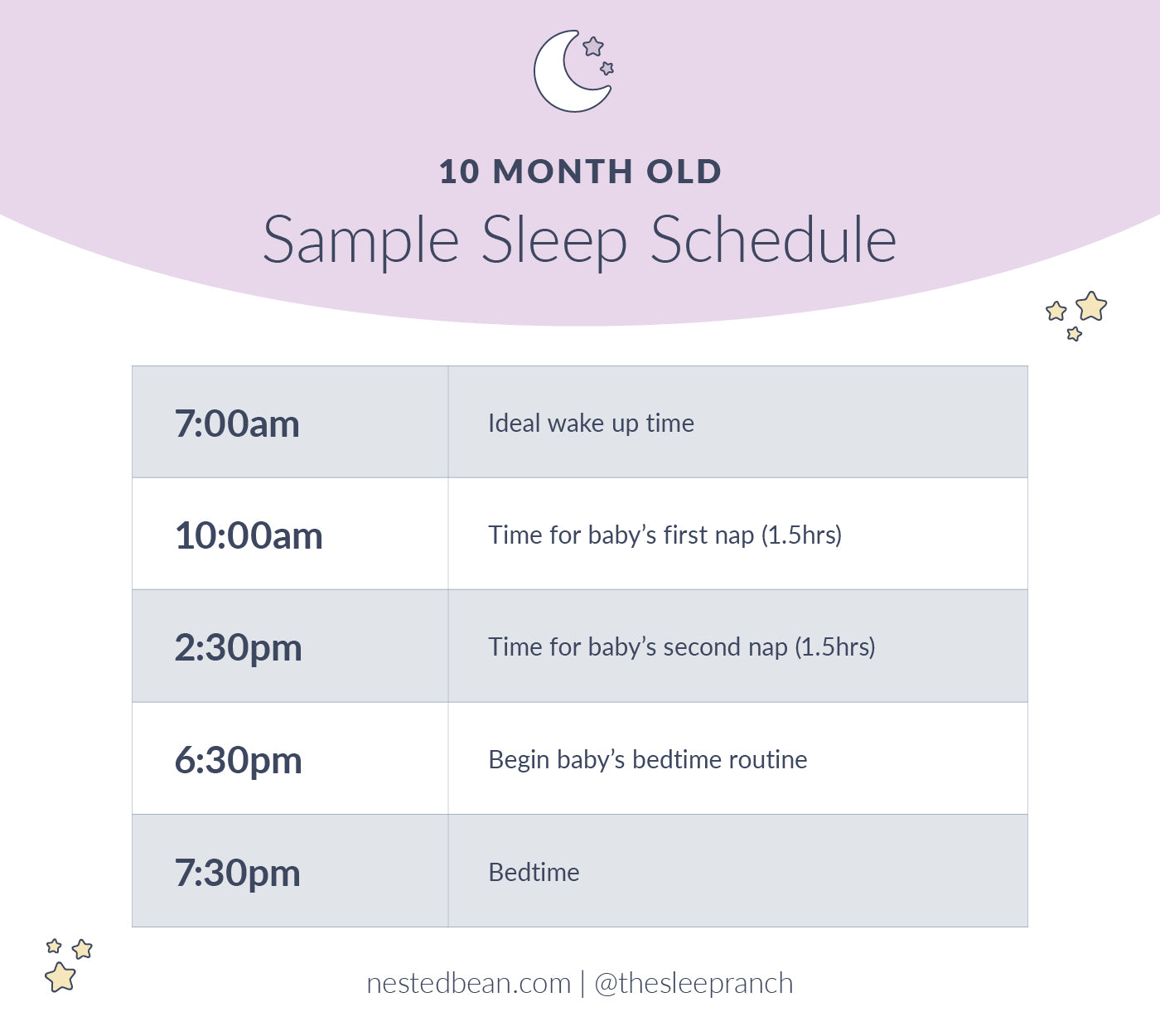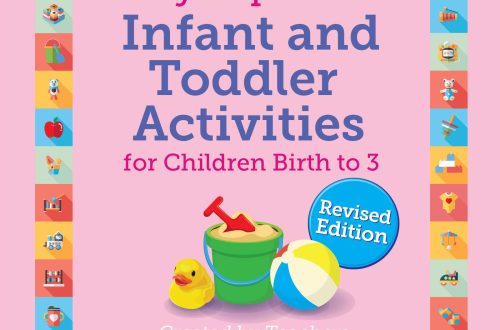
10-month-old sleep schedule– Nested Bean
Every parent knows going in that their baby probably won’t be letting them sleep much for the first few weeks. But they might not realise that sleep isn’t a straightforward path to no nighttime wake ups after the newborn phase!
Many people assume that their baby will be sleeping consistently through the night after only a few months, with issues rarely coming up after this. However, the reality of sleep for your 10 month old isn’t usually this easy – or forgiving!
Don’t panic though, as we’re here to help with some recommendations of how to combat sleepless nights and get your little one sleeping on a regular schedule.
In this blog, we’ll go through how much sleep your 10 month old baby needs, some example schedules, the 10 month sleep regression, and some tips on how to create and maintain the best schedule for you and your baby.
It’s tough to get your baby sleeping well when you don’t have the tools or the knowhow – if you want the lowdown on how to get your baby on a sleep schedule, just read on!
In this article:
10-month old baby sleep needs
Your 10 month old might be in the double digits month-wise and starting to enter toddlerhood, but they still need almost as much sleep as they did when they were half their current age!
The Sleep Foundation recommends that 10 month old babies sleep for between 12 and 15 hours per day, while Stanford Children’s Health states that 14 hours per day is the optimal amount for this age group.
But you should bear in mind when looking at statistics like these that every baby is unique – if your baby sleeps a little more or less than this, they’re likely still perfectly healthy and it shouldn’t be too much of a concern.
How to establish a sleep schedule for a 10-month old
While you’re figuring out what your baby’s sleep schedule might look like, it can be useful to make note of the times of day when your baby sleeps, eats, and plays. That way, you can keep track of their habits and behaviours and build the schedule in a way that works with their natural rhythms.
You can keep revisiting the schedule if these habits change to make sure it still works with your baby as they grow and develop.
After you’ve created the schedule, you can encourage it by making sure that naps always take place in the same place and at the same time. This creates positive sleep associations and will help your baby understand when it’s time to fall asleep.
You should plan for the morning routine first as babies sometimes struggle to fall asleep if they’re too tired. After this, you can stretch out the time between sleeping hours so that your whole schedule eventually comes together!
10-month old sleep schedule
Here is an example of what a sleep schedule for a 10 month old baby might look like. Remember – it’s completely normal, and expected, for yours to look a little different to this to match your own baby’s needs.
10-month old sleep regressions
But no matter how well planned your schedule is, there’s a high chance that you and your baby will have to deal with the 10 month sleep regression. This is a stretch of time characterised by sleep issues like nighttime and early morning wake ups, trouble sleeping, less nighttime sleep and more daytime sleep.
Usually, a sleep regression will come about due to your baby reaching developmental milestones like starting to walk, and can also be triggered by problems like teething pain and separation anxiety.
It only lasts for a few weeks for most babies, but parents know that weeks can feel like months when you’re sleep deprived! If you’re worried about the 10 month sleep regression or currently dealing with it yourself, you can check out our blog full of advice for dealing sleep regressions at any age.
Remember to keep your schedule as consistent as you can during this sleep regression – we promise that your baby will remember their routine when they settle and that your hard work won’t be for nothing!
Tips for getting 10-month old on a sleep schedule
So, once you’ve laid out the perfect schedule for your little one, it’s time to start thinking about how you’re going to get them to follow it! Here are our top tips for helping your baby adjust to a new schedule.
Give baby enough awake time
At 10 months old, your baby will likely want to spend a little more time awake between naps than they did before. If they don’t get enough time to play and explore before they sleep, they might be more likely to fight sleep and resist the schedule.
So, make sure they burn off that energy before you tuck them in! Playing with them during the time between naps lets them practice their new skills at the times you want them to, and might tire them out just enough to help them sleep soundly during their naps.
Nested Bean Zen Sack
If you find that your baby has trouble falling asleep on their new schedule, why not try our Zen Sack?
This wearable blanket is gently weighted to mimic your soothing touch, and can encourage your baby to learn how to self soothe through wake ups when you aren’t around by helping them feel snug and secure through nap time and nighttime.
Tuck your baby in while they’re drowsy
It’s no fun laying in bed when you’re wide awake, and babies certainly don’t like this feeling either! That’s why it’s best to try to put them to bed when they’re drowsy – you can do this by keeping an eye on their sleep cues.
These can range from more classic signals like yawning and stretching to more subtle signs like blinking more. Make a note of when your baby seems to get sleepy and integrate it into your schedule for them.
It’s also good to put them to bed while drowsy but still awake rather than fully asleep. This is to prevent forming negative sleep associations that require your presence to help them fall asleep and aren’t sustainable in the long term.
Create a soothing sleep environment
Though there’s a good chance you’ve put hours and hours of thought into how you decorate your baby’s sleep space, you should also make room for some practical elements of interior design.
If you live in a noisy apartment building or a city that stays busy through the night, you may find that this keeps your baby up through their scheduled sleeping time.
By using products like blackout blinds and a baby safe white noise machine, you can keep the room dark and quiet enough for your baby to sleep soundly.
Follow the eat, wake, sleep cycle
If you’ve never heard of the eat, wake, sleep cycle before, it’s pretty straightforward; just feed your baby when they wake up, try to keep them awake until bedtime, then put them to sleep.
This actually has two benefits. The first is that your baby is more likely to take a larger feed when they’re wide awake, and will therefore be able to sleep for longer without waking up hungry.
The second is that you’re preventing the negative sleep association of being fed to sleep, instead promoting good sleep habits that can follow them into toddlerhood and childhood.
Establish a calming bedtime routine
This goes hand in hand with having a calm sleep space! If you want your baby to settle into the stretch of night sleep you’ve planned for them, you should try to make the period before sleep as relaxing as you can.
Whether your routine involves a warm bath and a long story or simply a kiss and cuddle goodnight, doing this each night gives your baby a better chance of falling asleep and staying asleep.
Stay consistent!
This is definitely the most important tip, and one that we can’t emphasise enough! No matter how your schedule looks, you have to make sure that you stick to it, even through tricky times like sleep regressions and the holiday period.
If you do this, your little one will have a better understanding of when it’s awake time and when it’s nap time or bedtime, and therefore feel more settled.
This is a great foundation to set for your baby’s sleep patterns in the future, and promotes self soothing by giving them the sense of security they need to feel calm enough to fall asleep alone.
Printable 10-month old Sleep Schedule

Here is a printable example of a sleep schedule a 10 month old might have. Again, every baby is unique, so don’t expect yours to perfectly resemble this!
Other Sleep Resources
Healthychildren.Org: Sleep
Mayo Clinic: Toddler Health
American Academy of Pediatrics: Sleep: Normal Patterns
American Academy of Family Physicians: Know About Sleep for Your Child
FAQ: Common questions from new parents
How long will a 10-month old nap?
At 10 months old, your baby will need around 14 hours of sleep per day, with about 3 hours of this sleep taking place during the day. As your baby’s nap should last between half an hour to 2 hours, you can divide this in a way that suits you and your family. For example, you could have 3 naps that are each an hour long, or two naps that are 90 minutes in length – as long as you stay consistent, what matters is that your baby is getting enough sleep.
What time should a 10-month old go to bed?
Again, this is highly dependent on your baby and your family and isn’t a question with one easy answer! If your baby wakes up at 6:30am, they likely won’t be awake until 9:00pm – likewise, if they wake up at 8:00am, they might be too restless to sleep at 7:00pm! What matters most is that your baby gets enough sleep throughout the day – when this sleep happens is less important. Sleep schedules aren’t one size fits all, and you should do what works best for your baby.
Will a 10-month old sleep through the night?
At 10 months old, your baby should be able to sleep for 8 hours or so through the night without needing to wake up for a feed, so hypothetically yes. But this isn’t actually the reality for many parents – in fact, a third of babies were found to not be sleeping through the night at the 6 month mark, and this can still carry through a few months down the line. The important thing is not to worry too much – they’ll get there eventually, and there’s lots you can do to help them there. Creating a schedule that works with when your baby naturally falls asleep can help, as can sleep aids like blackout curtains, a baby safe white noise machine, and our gently weighted Zen Sack wearable blanket!
What is the 10 month sleep regression?
The 10 month sleep regression is a period of disrupted sleep that comes after a stretch of consistently good sleep. It usually comes with light sleep, shorter naps, more frequent nighttime wake ups, and being fussier at bedtime. It’s important to remember that this sleep regression is only temporary, usually lasting a few weeks, and your baby will be sleeping more peacefully again soon. If your baby is on a sleep schedule already, you should try to maintain it as best you can, as this gives them a sense of security and routine to return to one they’ve settled.
Should I start sleep training my 10 month old baby?
This is absolutely an option if you haven’t started to sleep train your baby already. There are plenty of methods out there, from the Ferber method to Pick Up Put Down, so find the sleep training method that suits your family best and stick with it! Consistency is the most important thing for a sleep trained baby, so don’t casually switch up methods unless you’re certain you’ll stick to the new one.
March 18, 2022
Athena S.




